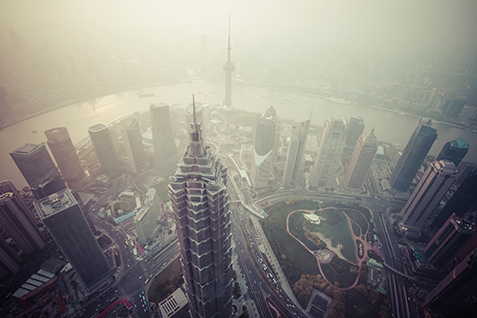

Though it is currently grappling with a catastrophic air pollution crisis, China hopes to redefine its economy and become a dominant player in the world’s green energy future. How the country plans to accomplish this monumental goal is the focus of Professor Dan Gardner’s newest research.
/ Published February 26, 2016
China’s attempts to address environmental issues could make the country a dominant player in the world’s clean energy future. Daniel Gardner, the Dwight W. Morrow Professor of History, says there should be no doubt that the Chinese are resolute about doing their part in both solving their country’s air quality problems and promoting an international climate change agreement.
The impetus begins with the challenges China faces in managing a catastrophic air pollution crisis that has become a deadly public health menace by any standard.
Their dedication to new clean air policies, driven by public pressure and forward-thinking people, means that the ruling party is equally committed to generating electricity in ways that don’t involve the burning of fossil fuels, Gardner says. Today, coal accounts for 65 percent of the country’s energy production.
Consequently, China is going all out to grow its non–fossil fuel power generation at the same time that it strives to keep the economy itself growing. Trying to retrofit a dirty infrastructure while keeping up with increased demand for energy is a monumental task that may take decades. But the process is underway, the incentives to succeed are enormous.
Gardner, who specializes in the study of pre-modern Chinese culture and society, added a new strand to his professional interests in 2010 when he spent the summer in the Beijing office of the Natural Resources Defense Council meeting researchers and decision makers. He thought the environmental crisis would be “an interesting lens through which to gain an understanding of modern and contemporary China.”
He is currently writing a book, “Environmental Pollution in China,” forthcoming from Oxford University Press in 2017. His scholarship “has always focused on crisis points,” says Gardner. His new interests fit that mold. “China has reached a tipping point where the country as a whole is in agreement that there is a problem and that it has to be addressed.”
Meeting the potentially gargantuan domestic and international demand for clean energy is something a command economy is arguably well suited for. And simply because of its scale, China is poised to become a leader in the solar and wind power industries.

Dan Gardner
China far outpaces the rest of the world in how much it invests in renewable energy. In 2014 it was $89.5 billion. Second was the United States at $51.8 billion. China is already the world’s largest producer and consumer of wind and hydroelectric energy. It is second only to Germany in solar energy production.
To further reduce carbon emissions, the country is planning to build as many as 400 additional nuclear power plants by 2050.
Pollution is animating China’s push for clean air. But China is also highly vulnerable to catastrophic climate change both on the coast and inland where warmer temperatures are already affecting agriculture. So it has strong incentives to examine every aspect of its national ecology for ways to reduce its carbon footprint, including urgently substituting other energy sources for coal-fired power plants.
China’s next five-year plan (2016–20), the 13th since the Communist revolution in 1949, will be published in March, and it is clear that clean energy will be a big part of it. “They see going green as good for the environment, but it is not at all lost on them that going green, in their view, will make them the world’s leading global economy in the next two decades,” says Gardner. “This is where they are investing their money.”
As new technologies are maturing more quickly than anticipated, Gardner says, China sees tremendous business opportunities in renewable energy. Global demand for solar panels and wind turbines are set to explode. China is investing in both the research and production necessary to be part of that boom.
The public health crisis caused by air pollution has pushed the Chinese to a “tipping point,” in Gardner’s estimation, which, as a follow-on effect, is positioning them to take a leading role in fighting greenhouse gasses. “I wouldn’t have said that ten, or even five, years ago.”
More immediately, China is confronting a pollution crisis that is causing health issues and shortening the lives of the Chinese people. Many urban areas are draped in an unremitting haze and smog alerts have become commonplace in daily life.
The will to clean up environmental pollution is there, but the momentum of a tremendous economy, together with strong political pressures to keep it growing, means that even with the huge investments China is making in a cleaner future, seeing results will take time.
“The Chinese people are more prosperous than ever. Because they are more prosperous, they are putting even more pressure on natural resources. They are eating more, they are buying more, they are driving more,” says Gardner.
He sees other tensions in play. The one-party state owes its legitimacy to a record of three decades of skyrocketing economic growth. Now, deadly pollution and a growing environmental movement could threaten that legitimacy. “The key question is how to protect the environment without curbing economic growth,” says Gardner. “I think they are desperately trying to figure that out.”
A study covering the years 1981–2001, by an international group of researchers led by the Massachusetts Institute of Technology, shows that life expectancy in northern China is at least five years shorter than in the south. The difference is that the north burns more coal because it is colder, and the heavier burden of toxic pollutants is taking a toll on life expectancy. Another report, conducted by the World Health Organization in 2010 and released in 2013, shows that 1.2 million Chinese died prematurely in 2010 alone due to respiratory diseases.

“That’s an incredible number, and it’s a number that received wide attention in China,” says Gardner. “People are becoming increasingly aware that the air they are breathing isn’t just uncomfortable, causing scratchy throats and sniveling noses, but that it is actually killing them.”
This knowledge is taking hold everywhere in the country. The impact is biggest where pollution is most concentrated. “What the people know now and didn’t know ten years ago is that when a coal-fired power plant, a battery plant, a petrochemical plant or an incinerator goes in down the street it’s going to affect their health. More importantly, it’s going to affect their children’s health,” says Gardner. That is a very big deal, especially in a country where an entire population of families have lived for almost four decades with the restrictions of a one-child policy.
Street protests in what is largely a not-in-my-backyard environmental movement have risen 29 percent in each of the past 20 years, according to Gardner. “The last thing the Chinese government wants is street protests.”
Then there is the global impact of the skyrocketing energy consumption that is driving the air pollution crisis. “Scale is always the context” when talking about China and the world, says Gardner.
China produces almost 30 percent of the world’s greenhouse gas emissions, almost double what comes from the United States. “Shutting down coal” is a big part of the puzzle in figuring out how to solve this problem, says Gardner.
This confluence of its desire to reverse catastrophic air pollution by rapidly growing its clean energy sector with the mounting realization that global warming is moving center stage in international relations is one of the reasons China is eager to promote international agreements to limit carbon emissions.
They were a “hero” of the recent COP21 climate change conference in Paris by playing intermediary between the industrialized and developing countries, says Gardner. Pushing hard for a Green Climate Fund to help poor countries deploy more alternative energy not only burnished China’s reputation as a leader on climate change but also made good business sense.
“The Chinese are very strategic and the government is very smart,” says Gardner. It was no coincidence that when President Xi Jinping left Paris he went to Africa for four days “to offer all sorts of aid,” mostly in the form of loans and export credits. He is paying close attention to Latin America. As those regions develop economically, adds Gardner, “China is betting that they are going to do it with cheap solar panels and cheap wind turbines from China.”

“The Chinese people are more prosperous than ever. Because they are more prosperous they are putting even more pressure on natural resources. They are eating more, they are buying more, they are driving more,” says Gardner.
Still, in spite of the country’s earnest commitment to combating climate change, the scale of the problem at home is huge and the effects are already being felt.
China is highly vulnerable to dire consequences of rising temperatures, and the nation’s fresh water and food security are potentially at stake. There are more than 48,000 glaciers in the Himalayas and they have already receded by a third in volume in the last 100 years, says Gardner. This has ominous implications because “as they recede they provide less runoff” as the sources of both the Yellow River and the Yangtze River. “Already in China 300 million people do not have access to clean drinking water,” he says. There are also consequences for hygiene and agriculture.
On the other side of the country, China has hugely populated low-lying coastal cities. They are among the most vulnerable cities in the world to rising sea levels, with Shanghai being at the very top of some lists, according to Gardner. Sea level has been rising about an inch per decade for the last three decades and “they are really nervous,” not only because of the obvious dangers of flooding, but because coastal territories account for 73 percent of China’s gross domestic product (GDP).
The good news is that the Chinese have become acutely aware of the problem. “There is not a person in China whom I have met, there is not an authority in China whom I have read who would argue that climate change isn’t real,” says Gardner. “Nowhere in China is there denial of the reality of climate change.”
The question remains, can the momentum of economic growth and the widening prosperity of a growing population be offset with what is shaping up to be an all-out effort to redefine its energy sector?

















